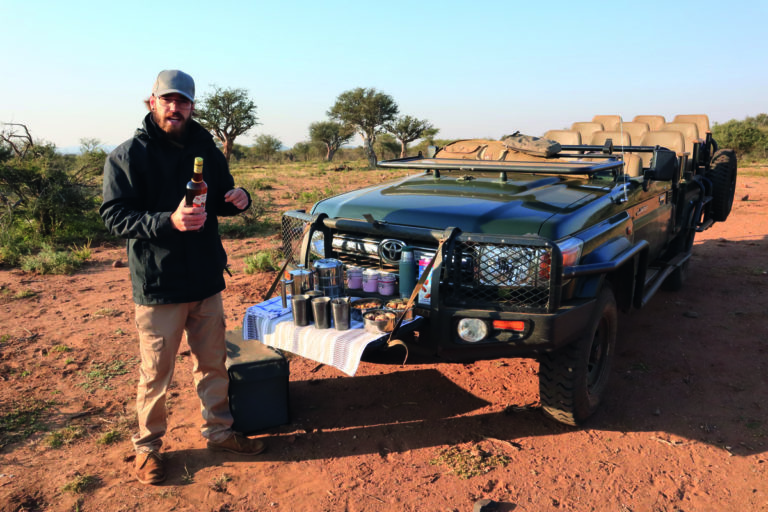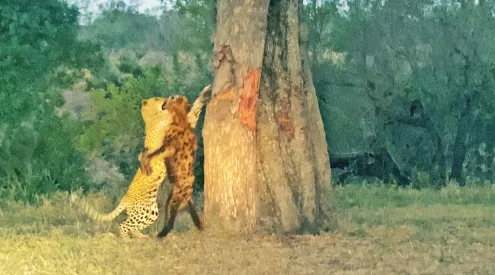Anton Crone bypasses an old haunt in favour of Madikwe’s wild call.
We passed the turn-off to Sun City, a place I was a little too familiar with. When I worked in Joburg back in the ’90s, that was as far as my weekend escapes took me. If only I had known what lay beyond.
Rounding the Pilanesberg, I regaled my wife, Sarah, with Sun City stories – a blur of rock concerts, feathered dancers, shiny coins and spinning wheels. When the hills were behind us I finally shut up and we were quiet and reflective, inspired by the rust-coloured landscape more than the gambling palace.

People gambled here too, you could tell by the dusty pastures for small herds of goats and cattle. Villages became more spartan; wood and daub replaced brick. After going through Molatedi Gate on the edge of Madikwe Game Reserve, our travel back in time was complete, and within a few minutes, we were basking in the shadow of elephants, a herd of about 40 making its way across the track in front of our car, calves shuffling between the legs of their protectors.
While this and other herds are relative newcomers to the area, the last census put the elephant population at 900, giving Madikwe the highest concentration of ellies in a South African protected area.
We encountered a second herd as we turned north where the red earth rose to granite hills and our first stop, Madikwe Hills Private Game Lodge. This luxurious stay was spread among vast boulders and acacia trees that dictated the course of winding boardwalks. Green wood hoopoes cackled as we walked beneath their tree. iNhlekabafazi is their isiZulu name, meaning laughing women. They chorused every time we passed through our chalet door. Our abode had the cool flank of a boulder as a wall; a stone stairway took us to a sprawling bathroom, mirrored outside by another bath and shower, open to the sky. A wooden stairway above a plunge pool led to a deck overlooking the plains and a waterhole where thirsty elephants drank, rumbling their satisfaction.
We didn’t want to leave this scene, but our stomachs were rumbling too, and we made our way to the dining area where the vista was magnified by a larger waterhole, more elephants, wildebeest, and a brave jackal darting between the giant beasts to steal a sip of water.

The mark of a perfect lodge location is one you don’t want to leave. We met proprietor Hannes Kruger who hadn’t left for 12 years, and when he did take a holiday it was often to his namesake park in the Lowveld. ‘The two environments are so different. It’s like another world,’ he said, making sure we were comfortable (‘very, thank you!’) and introducing us to Missy, his 11-year-old Staffie who’d called this home since she was a pup. Lucky bitch.
We were lured away to see less domestic creatures by head guide Ernst van Grunning and tracker Sydney Malthoko. Having spent his career in the likes of Hluhluwe-iMfolozi, Mkuzi, Sabi Sands and more, only Ernst’s beard was wilder than the man himself. He particularly liked Madikwe because it gave him the opportunity to track wildlife off-road. When it came to tracking, it was Sydney who had the eyes of an eagle.
Before long we were on the trail of two lionesses with youngsters in tow. We soon glimpsed their golden fur up ahead, then Ernst followed, steering the vehicle between small thickets until we came to a shepherd tree. A fresh wildebeest kill lay at the foot of the tree – mamma’s prize. The young lions rushed ahead and a bloody feast ensued; the clack of teeth on bone and growls over juicy morsels became the soundtrack.
Thus began a daily ritual of morning and evening drives so filled with wildlife activity that we wondered if it was staged. Ernst and Sydney didn’t leave things to chance. Radio reports of sightings were handy, but they also relied on tracking by foot when the bush became dense.

Stopping near a river one morning, they set off on the trail of fresh spoor and reappeared minutes later, walking faster than before. By the time they mounted the vehicle, a blonde-maned lion appeared about 80 metres behind them, followed by a pair of lionesses. They sauntered towards the water, freshened up, and then lay down to snooze.
The radio crackled – male cheetahs had been spotted in the southwest the previous night, and after scouring the area, Sydney spotted a small glob of blood amid bent grass – signs of a feast on small prey. Sydney and Ernst dismounted, studying the tracks in an ever-widening circle until they determined the direction they’d headed in. ‘We’ll probably find them on a termite mound a couple of kays from here,’ Ernst predicted.
Sure enough, that’s where we found them.
Later that morning, we came upon a devilishly handsome black-maned lion walking down the sandy red track as if he owned it. We followed him while he bellowed in a deep gravelly voice, and eventually, he reached the blonde male and his pride. He snorted his presence, then lay down and scowled from a safe distance. ‘They’re brothers,’ said Ernst. ‘So they get on alright.’
That evening, wild dogs surrounded our vehicle after making their way up a river bank, searching this way and that to pick up the scent of a quarry. When they got the scent, their white-tipped tails lifted like beacons, and they darted off into the gloaming with fierce intent.

iNhlekabafazi bid us a raucous farewell the next day, but we lingered at Madikwe Hills a bit longer to watch a pair of klipspringers prancing along the boulders between the chalets. There was never a dull moment in the hills. We had enjoyed breakfast that morning under the gaze of a variegated bush snake in the tree above, where masked weavers fussed over their nests among the acacia thorns.
Having torn ourselves away, we headed south to a different biome – a lush riverine forest along the Marico River. The area is home to orange-breasted bush shrikes, woodland kingfishers and Meyer’s parrots, which like their trees tall and shady. And it’s home to Jaci’s Tree Lodge, where a bushshrike’s lilting chorus welcomed us to our treehouse suite, reached via a boardwalk, floating through the tamboti trees.
Bushbuck blended with the dappled shadows below the deck, and the thatched roof, wood, and glass sides of the treehouse melded into the surrounds, offset with colourful interior decor, mimicking the birds’ bright plumage.
Proprietor Jaci van Heteren is the colourful character behind this charming lodge, along with her husband Jan. We met Jaci on the new viewing deck overlooking a large waterhole. The deck doubles as a dining venue in the evenings, where chefs cook over an open fire and lights illuminate activity at the water. ‘I virtually lived up here during the lockdown, using the viewing deck as an office,’ she said. Always on the go, she said the time helped her to slow down.
As we chatted with Jaci, a large herd of elephants paraded close by, making their way along the water’s edge. Weaver birds flew past carrying fresh nesting material, antelope wandered to and fro, and a young, submerged crocodile lingered, waiting for small pickings like yellow-billed storks.

The croc took us by surprise one afternoon as we peered out from the aptly named Terrapin Hide built alongside the waterhole. Reached via a tunnel, the hide’s viewing ports are just above the water, giving guests an extraordinary view of the wildlife. Elephants are almost close enough to touch as they siphon water from the nearby bank, and the opposite bank is a hive of activity – a photographer’s dream. It was while filming an elephant calf playfully waving its trunk about that the crocodile popped above the water surface directly in front of us, and leered at me through golden green eyes.
Another pair of eyes followed us as we visited the sister camp, Jaci’s Safari Lodge. In a tree outside one of the new luxury Star Bed Suites, a beautifully camouflaged African scops owl eventually betrayed its location by calling one too many times. Still, it was difficult to find the bark-patterned bird – it’s southern Africa’s smallest owl, and when we did find it, it kept so still, engaging us in a staring contest we could never win.
Less camouflaged and more in keeping with Jaci’s colourful vibe were the murals of wildlife – the work of Cape Town street artist Falko One – on the rear walls of the Star Bed Suites, a refreshing take on safari decor.
As good as the wildlife was, we didn’t just linger around the lodges. Forays with guide Dwayne de Lange to the western side of the reserve, near the Botswana border, led to creatures we seldom encountered, such as aardwolf and spotted hyena pups, two of which cavorted near the mouth of their den at sunset. Elephants were ever-present, as well as large towers of giraffes browsing on tall trees in the river valley. We even met up with old friends, the lion pride that we were introduced to on our first day, this time on another fresh kill near the airstrip – what a welcoming that would be for a fly-in safari.
Our last night was particularly special. After gin-infused sundowners, Sarah and I took up digs in Naledi Treehouse, a more rustic affair overlooking the waterhole. One feature was the wood-fired hot tub where we relaxed while watching the stars reflected by the waterhole. There was no wildlife to be seen until an African civet scampered into view just below the treehouse, its spotted fur illuminated by the lights.
As it searched along the water’s edge, a lapwing took flight and dive-bombed the civet from above – presumably to protect its eggs. The civet scampered into the darkness and things quietened until only crickets could be heard. Then, at the far edge of the clearing, a grey ghost emerged from the darkness, gliding ever so silently to the water’s edge, where it stopped and drank from the stars.

Trip planner
Madikwe Game Reserve is 400km, approximately a four-and-a-half-hour drive, from Joburg via Sun City or Zeerust. After reaching Molatedi Gate, the time it takes to drive to each lodge varies. A map of Madikwe is provided at the gate. Private vehicles may only travel to and from their lodge. Game drives are reserved for safari vehicles.
Do this
If you want a hands-on experience that you will remember forever, Madikwe offers opportunities for guests to participate in rhino notching activities. It is by no means cheap, but the paid experience is what supplements the huge cost of the reserve’s notching programme, vital not only in keeping track of the animals as part of the anti-poaching programme but also to build a DNA identification library of the rhinos.
Costs accrue due to the need for a helicopter, a vet and a tranquilliser. During notching, the attendant vet shares incredibly intimate details about rhino biology with guests. And, there is a moment when you get to feel the wonderfully soft, velvety spot behind the anaesthetised rhino’s ears. It’s a moment you will not soon forget. If ever.
Other special moments for guests in the reserve include cheetah collaring and wild dog collaring, both of which are premium activities, but unforgettable. If you wish to participate in one of these activities during your visit, enquire at the time of booking your stay as arrangements need to be made well in advance.
Stay here
Apart from our recommendations below, you can find more places to stay within the reserve at madikwegamereserve.co.za
Jaci’s Tree Lodge
Enquire about the more family-orientated lodgings at nearby Jaci’s Safari Lodge, as well as the two exclusive Starbed Suites.
083 700 2071
Jamala Madikwe
The expansive rooms (with everything from fireplaces and walk-in dressing rooms to ultra-chic linens on beds that, unsurprisingly, face the outdoor action) and all the public areas (multiple lounges, indoor and outdoor dining areas, and a small spa) have been imaginatively kitted out with beautiful fabrics, awesome photographs, books and board games, beautiful basketry, handcrafted ornaments, the whole perfectly pampering shebang.
082 927 3129
Madikwe Hills Private Game Lodge
Nearby Little Madikwe is a luxurious, self-contained two-bedroom private villa for four or five guests; it comes with its own safari vehicle and ranger, gourmet kitchen, wine selection and dedicated villa attendant.
011 781 5431
A version of this article appeared in the September 2022 print issue of Getaway
Words and photography: Anton Crone
Follow us on social media for more travel news, inspiration, and guides. You can also tag us to be featured.
TikTok | Instagram | Facebook | Twitter
ALSO READ: Exploring Namibia: 15 must-do activities and places to visit






















